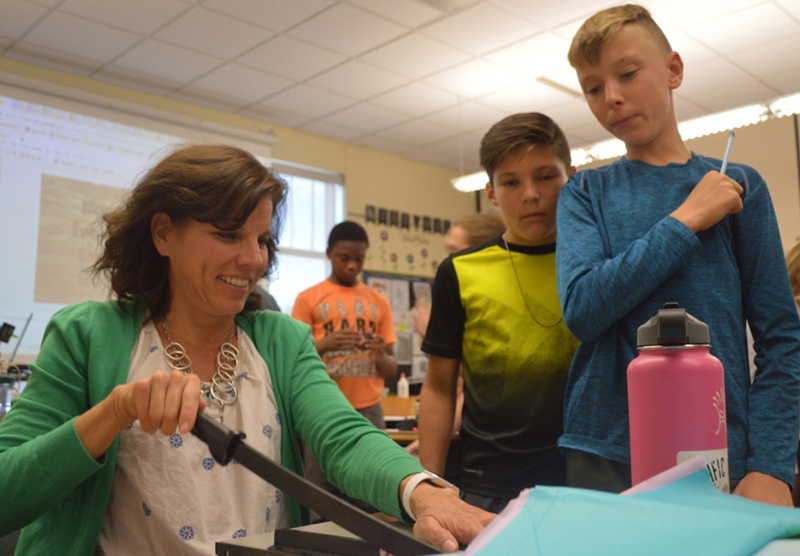At Century Park Learning Center, a riot of color swirling like a Chihuly tangle of glass sprouted all over the school. The inspiration for students: picture book illustrations found in Caldecott winners.
Rainbow-beaked birds like toucans dangled overhead, like Richard Egielski’s illustrations in “Hey, Al” (1987 Medal). Dapper spiders crawled up the wall, like those in Tony DiTerlizzi’s “The Spider and the Fly” (2003 Honor). Kid-sized, mischievous monsters with enormous, googly eyes romped through the kindergarten wing, with horns, claws and teeth like Maurice Sendak’s “Where the Wild Things Are” (1964 Medal).
“It’s just fun in here,” said third-grader Zoey Van Heest, whose class made a watercolor into a hanging scroll based on “Lon Po Po: A Red-Riding Hood Story from China,” written and illustrated by Ed Young (1990 Medal).
It was all for Art Walk at Century Park, an annual fundraising showcase of student art that celebrates illustrations from Caldecott books. Annually, the American Library Association honors children’s book authors and artists. Every classroom, from young fives to sixth grade, selects a book to honor.

Why Art?
Art teacher Melissa Vecchio said access to art and literature allows students to explore new mediums and techniques, test new ideas and build vital problem-solving skills.
“Art gives students a chance to express themselves in new and challenging ways,” Vecchio said. “In an increasingly visual world, it is important for students to know how to decipher and communicate visually. Art also builds observational skills.”
Fifth-grade students in teacher Winona Schneider’s class worked in groups to design enormous cats based on Brendan Wenzel’s “They All Saw a Cat.” Using circles of paint on a styrofoam plate, three students stamped hundreds of bright dots on theirs.
Nearby, two boys fashioned a replica of the “everything cat” from cut paper. Other students created one from the bird’s vantage point as it flew overhead. “So the cat has a lot of different looks based on who’s looking at him,” said fifth-grader Maya Wiszczur, who was working with Katie Weiss.

“I like the idea of … all these different perspectives of the cat perceived by other animals,” Schneider said. “I teach fifth-grade history. We’re always talking about things from others’ points of views and perspectives, and we explore how that can change our initial thoughts.”
Sixth-grade teacher Kris Caterino’s room was full of whirling, brightly colored tissue. To capture the zany illusions in Dr. Seuss’ “If I Ran the Zoo” (1951 Medal), students built fantastical creatures with tissue, often combining body parts of different beasts, such as a baby pig-elephant.
“I wanted to make something outrageous, and this is crazy and fun,” said Kenna Bookwalter as she glued pink and blue strips of tissue onto her large, poster-size sketch with help from classmate Regan Maynard.
Art teacher Vecchio’s students explored Kachina figures inspired by the book “Arrow to the Sun” (1975 Medal), illustrated by Gerald McDermott. “The Kachina represent spirits of people and things important to the the Hopi Native Americans,” she said, explaining students studied examples made by the Hopi and their color themes.
“Art helps students communicate and express things through a different outlet, ideas that they may not be able to express verbally,” she said. “It allows them to use their imagination and creativity, and express these ideas in a different, but visible way.”
CONNECT












